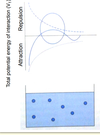L13 - Suspension - Liquid Phase Interactions Flashcards
what is needed for solid material to dissolve
- will not dissolve unless liquid phase has some chemical similarities
what appens when hydrophoibc drugs are dispersed in water
- very low aqueous solubility
- their biological target is often a hydrophobic receptor
- once dispersed in water, drug particle will acquire a charge
what causes the charge on the particle
- ionisation of water
- H2O ⇌ H+ + OH-
- H+ + H2O ⇌ H3O+
What are the most mobile of the ionic products of water
- H+ > OH- (hydroxide ion) > H3O+ (hydronium ion)
describe the electric double layer for a single particle
- hydroxide ions collect on the surface of particle which gives it an apparent negative charge
- ovaerall the neutrlity of the system is maintained
- so gradiation of charge
- -ve n particle surface (fixed)
- +ve (diffuse) Grouy-Chapman Layetr

why do most particles dispersed in water acquire a negative charge
perferential adsorption of hydroxyl ions
describe the graph for the conc of hydroxide ions and positive ions

What are the factors that affect the electrical double layer
- location of added materials n the electrical double layer of a single solid particle
- excipients ca change the beahvoir of solid particles in suspension (fixed layer, diffuse layer, or noth)
- examples
- NaCl at low conc (0.01M) - diffuse layer
- easier neutralisation of remaining surface charge on particle
- NaCl at high conc (0.1M) - diffuse and fixed layer
- NaCl at low conc (0.01M) - diffuse layer

What does the DVLO theory of collodial stability state
- stability of hydrophobic suspension
- collodial systems - multple articles
- interaction between particle are additive (VT)
- electrical repulsion (VR)
- van der Waals attraction (VA)
- VT = VA + VR
What are the repulsive and attractive forces
DVLO theory of collodial stability
- repilsive
- osmotic effects due to overlaps of the diffuse parts of electrical double layer
- attractive forces
- van der Waals and universal forces of attraction

What the the DVLO allow us to do
- predict whether suspension will coalesce and settle or remain sdispesed
what are the characteristic of the primary minimum
- attractive forces > kinetic energy
- particles show
- initally floculation, loosely attract but still independeant
- then, coagulation, particles collid to form larger particles
- undesireable behaviour for pharmacetical suspensions

What are the characteristics of the primary maximum
- replsive forces > attractive forces
- particles show
- defloculation, remain seperated
- consider KE of particle, KE increases with temp
- VT > KE
- as a result particles move apart and VT increase
- however
- sufficient KE → overcome VT barrier → move closer
- risky for pharmaceutical suspensions

What are the characteristics of the secondary minimum
- attractive forces > repulsive forces
- particles show
- limited attract to eachother and behave as “floccules”
- i.e. loose aggregates of individual particles
- limited attract to eachother and behave as “floccules”
- VT > KE
- result: particles move closer together but will not collide and coalesce as VT is small
- As VT incfreases, particles will experience weak repulsive forces
desireable

how is particle behaviour controlled in suspensios
wgat is constant and varied
- constant
- particulate material (drug)
- continuous phase (water because formulation for oral administration)
- variable
- distance of particles (partly dependant on temp - KE and particle conc)
- surface potential of particle (can be modified by adsorbing material onto particle)
- ionic strength
- radius of particles, e.g. VA, VR, and VT are directly proportional to particle size
- changes in size influences KE → impacts overall performance
descorbe particle movement in suspensions
- always some movement
- Browniam motion (relevant for particles upto a size of 1 to 2µm)
- diffusion of particles improves dosage uniformity
- important of deflocculated suspension of particles in submicrn rnage
- sedimentation
- relevant for particles > 0.5µm
stokes equation
what do the terms mean


is coagulation reversible
when does it occur
no
primary minimum
how can particle movement in suspension be reduced and therefore sedementation be reduced
- change desniy of medium ( continuous phase)
- e.g. addition of dextrose
- viscosit of medium (continuous phase
- e.g. addition of hydroxypropyl methyl cellulose
what happens if the continuous phase is too viscous
- difficult to pour/measure dose
- changes in particular dispersion pattern
- e.g. particles in primary minimum, coagulation →cannot be corrected
what are the advatnages of a flocculated system and what are the consideration
easy to disperse and dose
shake bottle


